Dr Jagraj Chawla obtained his MSc (Tech) in Technical Chemistry in 1956 from Panjab University. He retired in 1996 as Scientist G from Regional Research Laboratory Jammu and now lives in Canada. E-mail: drjagrajchawla@gmail.com
–
I was born on 13 April 1936. My association with Hoshiarpur began in 1938 when my father, Prof. Kartar Singh, was transferred to the Government College there after serving for about 10 years at Government College Ludhiana. A double M.A. from Punjab University Lahore in Political Science and Economics he taught these subjects at undergraduate and graduate level. Dr Vishwa Nath retired from Government service in June 1952, but was appointed University professor of Zoology, a higher ranking post. In December 1952, Dr Kewal Krishan Dewett was took charge as principal [1] who held the post till his retirement in 1958. Dr Dewett, like my father, had earlier been at Ludhiana.Movie Fifty Shades Darker (2017)Watch movie online Rings (2017)Watch movie online The Lego Batman Movie (2017)Watch movie online Logan (2017)Watch movie online John Wick: Chapter 2 (2017)Watch movie online Get Out (2017)
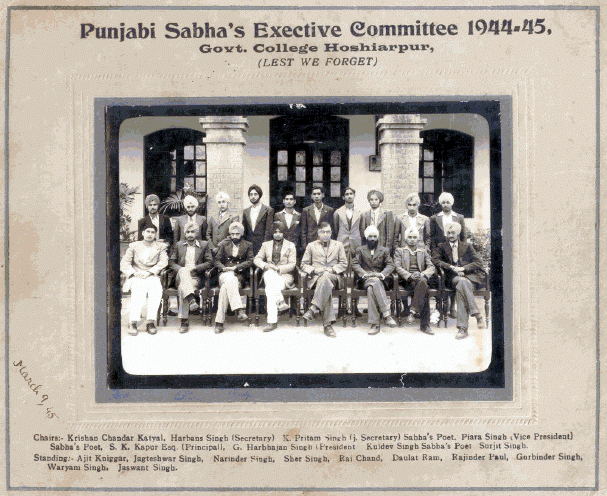
Government College Hoshiarpur Punjabi Sabha’s Exectutive Committee, 9 March 1945. Chairs, left to right: 1) Krishan Chandar Katyal; 2) Harbans Singh (Secretary); 3) K. Pritam Singh (Jt Secretary) Sabha’s poet; 4) Piara Singh (Vice-President) Sabha’s poet; 5) S. K. Kapoor (Principal); 6) G. Harbhajan Singh (President); 7) Kuldev Singh, Sabha’s poet; 8) Surjit Singh. Standing, left to right: Ajit Kniggar; 2) Jagteshwar Singh; 3) Narinder Singh; 4) Sher Singh; 5) Rai Chand; 6) Daulat Ram; 7) Rajinder Paul;8) Gurbinder Singh; 9) Waryam Singh; 10) Jaswant Singh
The infrastructure of the degree college was grossly inadequate to meet the requirements of a university An adjoining piece of land which used to be a ber (berry) orchard was acquired to build a separate wing for arts classes, an auditorium and an open air theatre. Principal’s office was shifted to this new building . Earlier a separate double story building was constructed for the Zoology honours school on the side of the play ground of the college . Later there came up separate very spacious playing grounds each for hockey , foot ball , cricket and tennis about a half a km away from the college .
The college did not have enough space in hostel to accommodate large number of students who migrated from Pakistan . The building of Islamia School being evacuee property was converted into a hostel. Some new houses had been constructed for refugees from Pakistan; they were also acquired for the hostel. The old hostel known as quadrangle was converted into class rooms to accommodate more classes.
Admission to the college was purely on merit. Most students with second class in matric got admission in the science subjects and others in arts . The college was a co-educational institution. The number of girls students however was small, 10-15 % with their number in science subjects being far less than in arts subjects. Panjab University issued instructions that children of its college teachers be given admission in the subjects of their choice and charged half fee.
Autobiography
I passed my matriculation examination from Government High School Hoshiarpur in 1950 and moved to Government College Hoshiarpur. After passing my intermediate examination in 1952 I joined the three-year BSc Honours School in Chemistry which I completed in 1955. In our batch of 30 students only four were girls students; in the senior batch there were none. Had I wished, I could have spent another year at the College and obtained MSc Honours School in Chemistry by research. I however opted for a one-year course in MSc Technical Chemistry at the University Department of Chemical Engineering housed since 1947 in Delhi Polytechnic ( later Delhi College of Engineering). The course consisted of chemical engineering, industrial chemistry, elementary civil, mechanical and electrical engineering, commercial economics and a research project of one’s choice. Perhaps our 1956 batch was the last one to do MSc Tech. Department of Chemical Engineering was the first one to be shifted to Chandigarh, in 1958 with Dr Ralph E. Peck of the Illinois Institute of Technology as the head. The older course of Masters in Technical Chemistry was discontinued and replaced by a new course in Chemical Engineering.
My MSc result was declared in December 1956. I went to Gurdaspur to spend some days with my elder brother who was at that time working as lecturer in zoology at Government College. In March 1957 there was a temporary vacancy of a lecturer at Panjab University College Hoshiarpur in chemistry. The appointment was for a period of three months, renewable till the post was filled permanently. I was the only candidate and was thus selected! After serving there as an ad-hoc lecturer for about 10 months, I joined Forest Research Institute Dehra Dun as a research scholar and obtained my PhD from Panjab University in 1963. From September 1963 till June 1964 I served as a Scientific Pool Officer in the Chemical Engineering and Technology Department. During this period, I taught industrial chemistry to chemistry honours school students when Dr. R. C. Paul was the Head of the Chemistry Department. Pool Officership was temporarily given by Council of Scientific and Industrial Research on the basis of selection made by Union Public Service Commission to those who were qualified but had no proper job at the moment. I then got a permanent job at the CSIR Regional Research Laboratory Jammu as Senior Scientific Officer. I retired in 1996 as Scientist G.
Teaching young energetic and restless undergraduate students when I myself was callow was a good learning experience. In my later life whenever I gave a research seminar I went well-prepared and remained conscious of the clock. As a temporary lecturer I had the good fortune of working under an eminent organic chemist. Dr Gurbaksh Singh who obtained his Ph D under the future (1965) chemistry Nobel laureate Robert Burns Woodward. Later he became the first vice-chancellor of University of Hyderabad and of Delhi University. His wife was a university teacher of classical music. His younger brother Sujan Singh was a student in the chemistry honours school . He used to be the student demonstrator for our chemistry class.
Incidentally we all four brothers studied in the Panjab University College Hoshiarpur. My eldest brother Jagteshwar had an interesting academic career. He had earlier repeatedly failed in Persian and, much to our father’s disappointment, decided to give up studies once and for all. He however changed his mind a few years later and went on to obtain his BA. Immediately elder to me, Narinder, was a student of MSc Honours School in Zoology . Narinder retired as principal of Government College Ropar in 1986. The youngest, Harpreet Chawla, is a dental surgeon practising at Hoshiarpur.
Dr Vishwa Nath
Dr. Vishwa Nath was well read and knowledgeable, a good scientist, a good research guide , a good teacher, a good writer, a very good speaker both in English and Hindi, and a very able administrator. He had well trimmed pepper salt moustaches, wore metallic framed spectacles, and was neatly dressed up. Though moderately tall, he had a good shapely physique. He was a good cricketer and cricket commentator. During annual sports of college there used to a staff race and Dr. Vishwa Nath won the race. It was fun to watch the staff members running . His son Rajinder was a cricketer of which fact Vishwa Nath was very proud.
In summer the college would start at 7 AM and close at 1.0 PM. Vishwa Nath got a loud speaker installed at the roof top at the middle wing building where before around 6-45 a.m. recorded shabads and bhajans were played and he himself would recite slokas from Gita . Later he appointed one music master who would play violin during the recital. This was just before the college classes started . The part-time music master was perhaps later absorbed into the university staff as a music teacher . I am not sure .
Vishwa Nath also introduced a compulsory Gandhi prayer class in the college, with the first period every Saturday reserved for it. During the class bhajans and shabads were sung. The Principal himself would recite Gita slokas and explain the meaning. My father Prof. Kartar Singh would do the vyakhya (explanation) of the shabads. He would give examples from Gurbani to the entire college gathered at that time in a very impressive , heart touching and convincing manner.
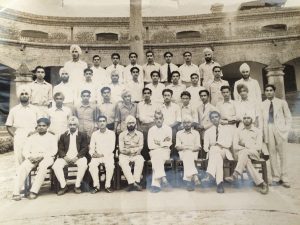
Government College Hoshiarpur Economics Society 1949. Chairs, left to right: 3) Prof. K. C. Palta; 4) Prof. Gurcharan Singh ( Head of Economics Department); 5) Principal Dr Vishwa Nath; 6) Prof . Kartar Singh. In the last row, standing at extreme right is Jagteshwar Singh ( author’s brother)
Both the staff and students were fearful of the Principal .They would think twice before entering his chamber. He was assertive and would boil with anger on small matters but would subside also in no time . Once, Dr Vishwa Nath refused admission to quite a number of students citing lack of space and furniture as the reason. Some suggested the name of Prof. Kartar Singh for review of his decision. Even though the staff members did not approve of the decision, nobody was ready to take up the issue with the Principal, because of his temperament. Finally the task fell on Prof . Kartar Singh. He took all the forms of the refused admissions cases and went to Dr Vishwa Nath after he returned from lunch. He was sitting in his chamber in relaxed mood. He asked: Kartar Singh ji, what is the matter? What has brought you? Vishwa Nath always addressed him with respect. Kartar Singh replied. ‘ Sir, this morning I heard your sermon from Gita . You spoke on karma . How and where good karma can be done . Before Vishwa Nath could say anything, Kartar Singh continued: “Do we have to go to a hospital or an orphanage to do so ? No, it is to be done where ever you are and in whatever you are doing. Even a peon sitting out side your office can do it by offering a chair and glass of water to a visitor. So many students have been refused admission. They are the people uprooted by partition of the country for no fault of their own, lost every thing, their dear ones , came on roof tops and buffers of railway trains even on railway engines to save their lives. Where should they go? They do not want furniture to sit on to attend classes . They would squat on the ground in open to get education. Now is the time to do good karma . Viswa Nath was much moved by Kartar Singh’s arguments. He changed his decision and admitted all the students.
Dewan Anand Kumar came from a very rich and influential family. He was a towering and charming personality with a radiant face and army officer-style moustache. He dressed like an English man wearing coat and tie and a felt hat. He even looked like an English man. And yet he was an eloquent speaker in Hindi and Urdu apart from English. While speaking in English, he could effortlessly transfer to Urdu. He once gave the convocation address also. He used to come to Hoshiarpur to teach students of zoology honour school. He used to come to Hoshiarpur to teach students of zoology honour school. One of the zoology students was a cousin of Yuvraj Karan Singh, Sadar- e -Riyasat of Jammu and Kashmir. Through this contact, Karan Singh was persuaded to come to deliver the convocation address in 1953 or so. Interestingly, at the time, he himself was an M. A. student though elsewhere. He came accompanied by his wife and mother. The glamorous Royals were a sight for all to see .
Faculty
English Department was headed (in an honorary capacity) by Hoshiarpur-born Prof. Diwan Chand Sharma. Of short statute and invariably attired in khadi kurta pajama, he was very influential in University affairs and also active in national politics. As a young student I was once given the task by a family of distributing wedding cards. The errand brought me to Prof. Sharma’s house who was holding court with many University and College members in respectful attendance. All were sitting on the floor. Interestingly, Sharma used to often hold his classes in the open sitting on his feet rather than squatting. His peculiar mode of sitting in the open often elicited amusing comments from passer-by students. On his (first) election to the Lok Sabha in 1952 he was felicitated by the College staff and prominent persons of the city at a function held in the open air theatre.
A British lady Miss A.G. Stock came as a reader in English. She was middle aged and would come to the college on a bicycle. Since she was a foreigner, students would listen to her attentively to learn English accent and benefit from her teaching . We simply used to watch the foreign lady as a staff member of Panjab University.
Oxford educated Gautam Mathur was appointed reader in economics . He once enacted a Shakespeare play on the college stage . In 1965 he took over as the Head of Economics Department at Osmania University and later became the Vice-Chancellor of Utkal University and Director, Indian Council for Applied Manpower Research.
Prof. S. M. Mukherjee was the head of the Chemistry department . The other staff members in the honours school included Drs B. R. Puri , K.S. Narang, Jagjit Singh , Inder Sen Gupta , M. L. Lakhanpal (who later became Vice Chancellor of Jammu University). Dr. Balwant Singh from Government College side used to teach inorganic chemistry . Dr. R.C Paul who later became head of the Chemistry Department and then Vice Chancellor was an unassuming personality; he was very helpful , friendly and sympathetic to the students . One could meet and talk to him freely without any inhibition . O. P Vij, Lekh Raj Sharma and Virender Singh Gaind were research scholars working for their Ph. D. Custom of adding a surname was not very common. Thus R.C. Paul was then simply known as Ram Chand ,and K.L. Jaura as Kundan Lal.
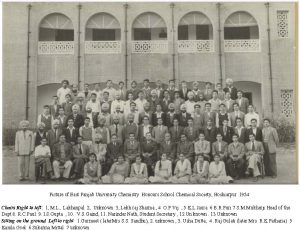
Chemistry Honours School Chemical Society 1954. Chairs, right to left : 1) M.L, Lakhanpal; 2) Unknown; 3) Lekh Raj Sharma; 4) O.P Vij; 5) K.L.Jaura; 6) B.R.Puri; 7) S.M.Mukherji Head of the Department; 8) R.C.Paul; 9) I.S.Gupta; 10. V.S.Gaind; 11) Narinder Nath, Student Secretary: 12) Unknown ; 13) Unknown. Sitting on the ground left to right 1) Gurmeet (Mrs S.S. Sandhu); 2. Unknown; 3) Usha Dutta; 4)Raj Gulati ( Mrs R.K Pathria); 5) Kamla Goel; 6) Sukarma Mittal; 7) Unknown
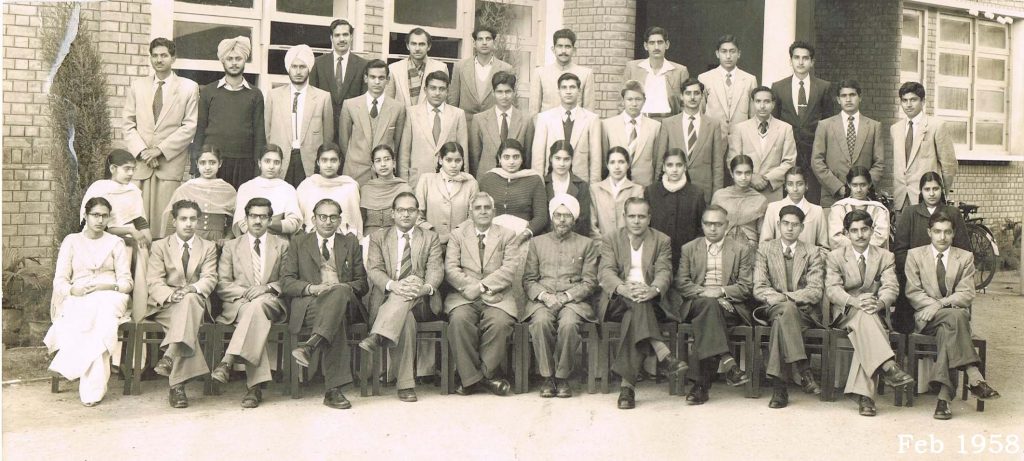
Photograph taken at the time of the retirement of Prof. Kartar Singh from Government College Hoshiarpur, Feb. 1958.
The following is partial list of faculty members not mentioned above, and drawn from memory (titles are omitted).
- G. P Sharma Zoology
- Prof G. L Arora Zoology
- H. R Sarna Physics
- H.R. Gupta Mathematics
- Balwant Singh Chemistry
- Bhim Sen Khanna Political Science
- J. D Verma Economics
- Apar Singh Chemistry
- Sukh Dayal Malik Zoology and in charge of horticulture in the college campus
- Harwant Singh English
- Kidar Nath Mehra History
- S.N Batra Urdu and Persion
- Wadhawa Singh Physical Training NCC
- Prof .Bansi Lal Juneja Mathematics
- Hari Ram Gupta History
- Pt. Paras Ram- History
- B.M. Anand Physics
- Kulwant Singh Chemistry
- Harkishan Lal Gupta Chemistry
- Uma Dutt Physics
- H.R . Bhatla Physics
- Prof . Hukam Chand Physics
- N.K. Gupta Zoology
- Ramesh Satija Zoology
- Prof .K.L Malhotra History
- Rajinder Singh Ahluwalia English
- Jagdish Chander English
- Gurbax Singh English
- Kishan Singh Thapar History
Almost everybody, students and teachers alike, rode bicycles, the only exception being A. C. Joshi who drove a black Baby Hindustan Car.
Extra-curricular activities
The college regularly celebrated Guruparab on Guru Nanak Dev ji’s birth anniversary with shabad kirtan by students and professional Ragis indian viagra 2. There was an active Gandhi Study circle. Dramatic Club regularly put up plays while Punjabi Society would organize kavi darbars in which students and outside poets took part. Music Club arranged inter-collegiate music competition . I used to play harmonium and accompany the singer and some time gave solo performance on harmonium. There was a TKT club also, but I have no idea about its activities.
Students
There was a single branch railway line connecting Hoshiarpur with Jullundur, about 40 km distant. Hoshiarpur was a terminus and the trains did not go beyond it. One of the pastimes of the students was to watch the engine turn to go back.
In 1951 there was a locust swarm, which we witnessed for the first time . The locust insects (full size about 7 cm long and 1 cm thick) came in millions like clouds. They would settle down at night on vegetation and trees and destroy the crops. This is their food. There was an emergency to fight the locusts . The district authorities approached the PU College and schools for help and the student community were asked to destroy the locust settled on trees at night. Batches of students would go at night in trucks with kerosene oil and spray pumps and burn the locusts settled on trees . The villagers were asked to collect the eggs which locusts lay in bunches. The authorities would pay Rs. 10 for 40 kg or so for the eggs and then destroy them. Small trenches were dug to destroy the hoppers which comes out from the eggs etc . There is a locust control department in many countries to meet the situation . The college remained closed for about 15 days, while the operation went on for months.
There were many students of those days who went on to achieve eminence . I remember many of them coming to the college with books and mingling with other students.
During 1954-55 Dr Manmohan Singh, the former finance minister and prime minister, was a student in MA economics with the Principal, Dr. K.K. Dewett , as one of his teachers. He stayed in the Model Town hostel campus, where many of my class fellows and chemistry honours mates and other college friends were there. He was a very quiet person and a gentleman. He was considered to be a genius. I never met him, but whenever we saw him in the college we commented that he is going to top the university in MA economics . And he did. He left for Cambridge and when he returned with PhD degree we saw him coming to the College very well dressed in double breast English suit with tie and looking smart . There used to an association of PU College ex-students at Delhi and I was told that he used to attend the meeting.
Dr Brijinder Nath Goswamy was a history student during 1950-55 . We often met him while coming to college on bicycle and also in the college . He would take part in college debates .He was also earlier a class mate of Dr. Manmohan Singh at Hindu College Amritsar . He was very intelligent, a very good speaker and a debater. He stood first in MA history and established a new record which till today has not been broken like Dr. Manmohan Singh’s record in MA Economics . We predicted that he would be an IAS officer. He was indeed selected by UPSC with 9th rank the for Indian Foreign Service and 11th for Indian Administrative Service . He however left IAS and joined the PU. He was later honoured with a Padma Shri and Padma Bhushan for his work on history of fine arts and paintings I don’t know much about his field of specialization . He is also a good writer, with his articles appearing regularly in The Tribune and other national newspapers . I talked to him after a very long time just once or twice on phone when he got the Padma awards and congratulated him . I was not sure whether after a lapse of so many years he would recollect or recognize me .I was happy that he recognized me at once . His wife was my wife’s class mate at Government College Amritsar during the 1950s. His younger brother Devinder was my class mate in 1950, but he was not a science student .
The well-known organic chemist Satinder Vir Kessar (b. June 1932) is like me a Hoshiarpur boy, where his father was a lawyer. Academics could have lost him. After his FSc Kessar joined the marine engineering college but left it. He then joined Indian army, but decided to leave the military college and return. After completing his BSc Honours School in Chemistry where he topped he appeared in the central services examination and was selected for the railway service. He however decided to complete his MSc and pursue research as a career.
Students who topped were appointed demonstrators for laboratory work by the juniors and were paid a monthly stipend of 50 rupees. Kessar in chemistry and Raj Kumar Pathria in Physics were our demonstrators.
Kessar obtained his PhD (1958) from the University of Southern California, Los Angeles, under the supervision of MC Kloetzel. After a brief stint as an Assistant Professor at the Punjab Engineering College, he joined the Department of Chemistry, Panjab University as a Lecturer (1959) and later became Reader (1963) and Professor (1974). He was CSIR Distinguished Chair (1992-97) and is continuing as an Emeritus Professor at Panjab University, Chandigarh. He was Chairman of Research Council of Regional Research Laboratory Jammu where I was employed as a scientist.
Dr. Bagicha Singh Minhas, economics, became member of the Planning Commission. Narendra Luther who did MA Political Science and was a good debater joined IAS in 1955 and became the Chief Secretary of Andhra Pradesh . His younger brother Virendra Luther did MA English and joined Central Services. He however soon resigned and took up appointment as lecturer in English in Chandigarh, only to leave it and join the gramophone company His Master’s Voice. Later he moved to Polydor.
During one of the dramas enacted by the College dramatic club at the open air theatre, Virendra had the mortification of having his glued moustache falling down. The audience was more interested in following the movement of the moustache on the floor due to the wind rather than the course of the play.
Pritam Singh Bhinder, MA (Economics), became the chief commissioner of Delhi. His wife Sukhwant Kaur, four times MP from Gurdaspur, was a minister of tourism. Umrao Singh, later a Punjab Minister, was an MA student of Political Science and a good hockey player. Rajinder Kumar Takkar, later Chief Secretary of Jammu and Kashmir, was a Political Science student at Hoshiarpur. Sohan Singh Misha, the Sahitya Akademi Prize-winning Punjabi poet, did his MA English from Hoshiarpur. [2]
Har Mohinder Kaur Sandhu became Judge of Panjab & Haryana High Court. P.S. Sahai , MA (Political Science, 1958) served as India’s Ambassador in Sweden and High Commissioner in Malaysia . K. K. Nayar was a student of Zoology honours , but could not complete the course for some reason. He joined All India Radio. He became quite well for interviewing celebrities . He used to be a good speaker during college times .
I remember some of the students of the 1950s because of their lineage: sons of Partap Singh Kairon, the then chief minister of Panjab; princes of Suket Mandi; and the son of S. Karnail Singh general manager Northern Railways and Chairman railway board. Karnail Singh’s elder brother Dalip Singh Saundh was Senator of USA during the 1950s. Karnail Singh’s son Amar Singh was my class mate and a close friend.
Hoshiarpur has given the University four Vice-Chancellors . While Amar Chand Joshi was a faculty member of the Government College, Ram Chand Paul and Ram Prakash Bambah were University appointees. Madan Mohan Puri was a student at Hoshiarpur wholjoined the University faculty in 1962 at Chandigarh.
Let me close by narrating an incidence from my Pool Officer days at Chandigarh, which I am sure is etched in many memories. Even though Panjab University Library had been in use for quite some time, it was suddenly declared in 1963 that it would be inaugurated by Prime Minister Jawaharlal Nehru. What was bringing him to Chandigarh was not the University but the Hindustan Machine Tools factory at Pinjore which he was inaugurating.
A tent was erected in the lawns that lay between the Library and the Chemical Engineering building. He was asked to press a button which through remote control was expected to open the curtain hung at the Library door . He pressed the button and the curtains did open, but not by some motor or technical device. He and everybody else could see the feet of two persons who were pulling the curtains on a cue. There was all-round laughter, with Nehru declaring good humouredly: Vice-Chancellor Sahib, hamare saath dhokha hua hai [I have been tricked] .
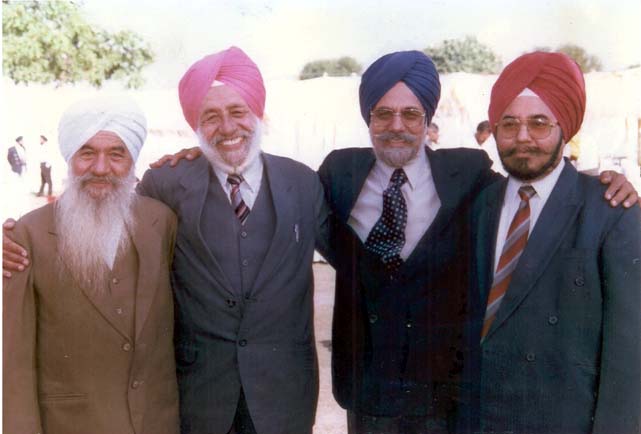
The four brothers, all students of Government/ University College Hoshiarpur. Left to right: Jagteshwar Singh Chawla, Narinder Singh Chawla, Jagraj Singh Chawla, Harpreet Singh Chawla
[1] Vishwa Nath however continued to function as the Principal on behalf of the University. The Government Education Department however objected, and appointed Dewett as the officiating Principal. The embarrassing situation came to an end with the University’s giving in. Dewett was succeeded by K. L. Malhotra who retired in 1959. The post now went to Dr J. D. Varma who served in an officiating capacity. R. R. Sethi and J. L. Mehta (1968) A History of the Panjab University Chandigarh 1947-1967 ( Chandigarh: Panjab University Publication Bureau); see p. 113.
[2] Sohan Singh Misha was earlier educated at Randhir College Kapurthala. His colleague from those days, Harbhajan Singh Hundal, noted that while almost everybody else came to the College in striped pyjamas, Misha was always well dressed, because his father was a tailor. See Amrit Lal Paul (2002) S. S. Misha (New Delhi: Sahitya Akademi), p. 10.
